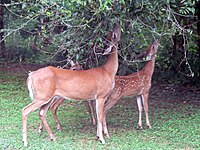
Scale-Dependent Influences of Distance and Vegetation on the Composition of Aboveground and Belowground Tropical Fungal Communities.
Sign Up to like & getrecommendations! Published in 2020 at "Microbial ecology"
DOI: 10.1007/s00248-020-01608-4
Abstract: Fungi provide essential ecosystem services and engage in a variety of symbiotic relationships with trees. In this study, we investigate the spatial relationship of trees and fungi at a community level. We characterized the spatial… read more here.
Keywords: community turnover; distance; fungal communities; belowground ... See more keywords

Biodiversity effects on resource use efficiency and community turnover of plankton in Lake Nansihu, China
Sign Up to like & getrecommendations! Published in 2017 at "Environmental Science and Pollution Research"
DOI: 10.1007/s11356-017-8758-2
Abstract: The relationship between biodiversity and ecosystem functioning is a central issue in ecology, especially in aquatic ecosystems due to the ecophysiological characteristics of plankton. Recently, ecologists have obtained conflicting conclusions while analyzing the influence of… read more here.
Keywords: community turnover; community; use efficiency; resource use ... See more keywords

Spatial community turnover of pollinators is relaxed by semi-natural habitats, but not by mass-flowering crops in agricultural landscapes
Sign Up to like & getrecommendations! Published in 2018 at "Biological Conservation"
DOI: 10.1016/j.biocon.2018.01.016
Abstract: Abstract Understanding beta-diversity, i.e. species turnover in space and time, is essential for informing conservation actions. Soaring cultivation of mass flowering crops (e.g. oil seed rape OSR) and loss of semi-natural habitats (SNH) can strongly… read more here.
Keywords: community turnover; mass flowering; turnover; semi natural ... See more keywords

Spatial scale and specialization affect how biogeography and functional traits predict long-term patterns of community turnover
Sign Up to like & getrecommendations! Published in 2017 at "Functional Ecology"
DOI: 10.1111/1365-2435.12716
Abstract: Summary Immigration, extirpation and persistence of individual populations of species are key processes determining community responses to environmental change. However, they are difficult to study over long time periods without corresponding historical and modern-day species… read more here.
Keywords: spatial scale; biogeographical variables; community turnover; community ... See more keywords